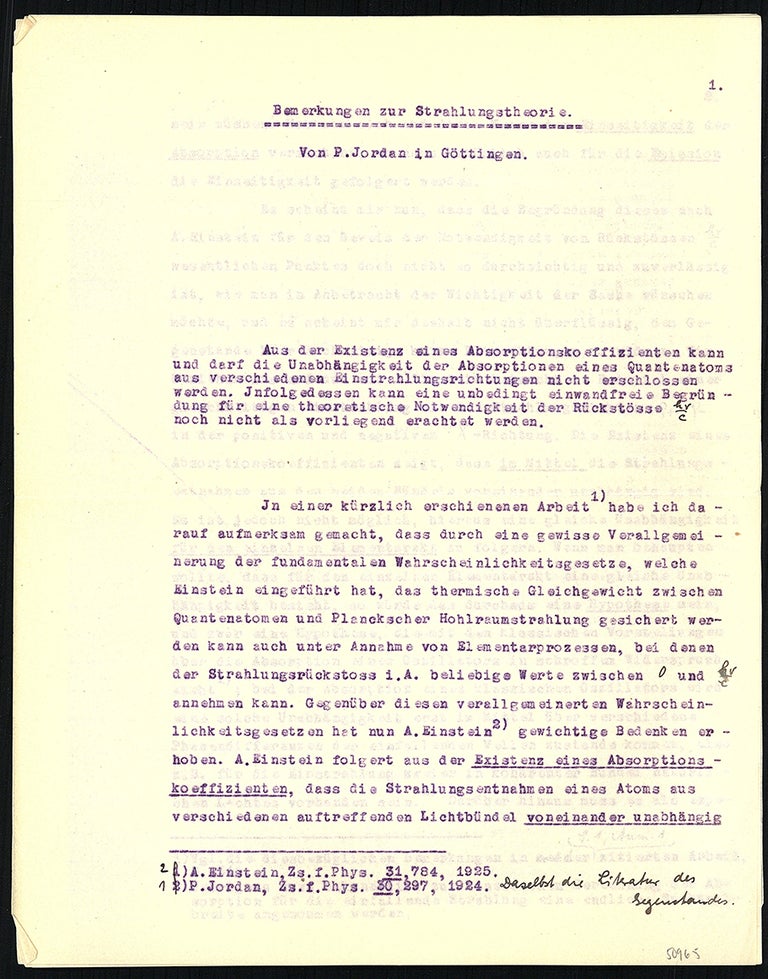
Bemerkungen zur Strahlungstheorie. Typescript with manuscript additions.
Publisher Information: 1925.
Jordan, Pascual (1902-80). Bemerkungen zur Strahlungstheorie. Carbon typescript in German, with manuscript additions. 6ff. N.p., n.d. [1925]. 286 x 225 mm. Creased horizontally, edges a bit crinkled, but very good.
Apparently Unpublished Paper written in response to Einstein’s “Bemerkung zu P. Jordans Abhandlung: ‘Zur Theorie der Quantenstrahlung’” (Zeitschrift für Physik 31 [March 1925]: 784-785). We can find no evidence that Jordan’s paper appeared in any journal, and this typescript copy, with formulae and other additions in Jordan’s hand, may be the only copy in existence.
Jordan, one of the authors of the famous Dreimännerarbeit on quantum matrix mechanics, obtained his doctorate in physics from Göttingen in 1924 with a thesis on the light-quantum problem, which was published in the Zeitschrift für Physik under the title “Zur Theorie der Quantenstrahlung” (Z. Phys. 30 [December 1924]: 297-319). At that time Bohr and other quantum physicists had raised a number of objections to Einstein’s old conception of light quanta, particularly with regard to the Compton effect, as they could not find a satisfactory way to integrate Einsteinian light quanta into the current quantum physics. In his thesis Jordan addressed this problem, seeking “to propose a compromise between the extreme positions of the light-quantum theory, as assumed by Einstein, and of the wave theory of radiation, as preferred by Niels Bohr on the basis of correspondence arguments. In particular, he made an attempt to modify Einstein’s theory of the interaction between electrons or atoms and radiation by avoiding an important assumption of the light-quantum theory: namely, the assumption that a light-quantum of energy h necessarily imparts a recoil momentum of magnitude h/c to the electron or atom” (Mehra & Rechenberg, The Historical Development of Quantum Theory, 3, p. 51).
Jordan’s proposal did not convince his fellow physicists, particularly Einstein, who summarized his objections in the above-referenced “Bemerkung zu P. Jordans Abhandlung: ‘Zur Theorie der Quantenstrahlung’” [Comment on P. Jordan’s paper: “On the theory of quantum radiation”]. Jordan’s reaction to "Einstein’s critique can be seen in the present typescript, which begins [English translation ours]:
In a recently published work I pointed out that by a certain generalization of the fundamental probability laws introduced by Einstein, the thermal equilibrium between quantum atoms and Planckian cavity radiation can also be secured under the assumption of elementary processes in which the radiative recoil can be assigned any values can assume between 0 and h/c. A. Einstein raised serious concerns about these generalized probability laws. A. Einstein concludes from the existence of an absorption coefficient that the radiation extraction of an atom from different incident light beams must be independent of each other. If one has assured oneself in this way of the one-sidedness of the absorption, one-sidedness must of course also be concluded for the emission.
"It now seems to me that the justification of this point, which according to A. Einstein is essential for the proof of the necessity of recoils h/c, is not as transparent and reliable as one would like in view of the importance of the matter, and it seems to me therefore not superfluous to devote a few more brief considerations to the subject here. . ."
We do not know why Jordan chose not to publish this paper, but we do know that he did not persist in maintaining his radiation thesis—in his next paper on the subject, published the following August, he followed Pauli’s, Einstein’s and Ehrenfests’s treatments of the processes involved (Mehra & Rechenberg, p. 52).
Book Id: 50965Price: $7,500.00
